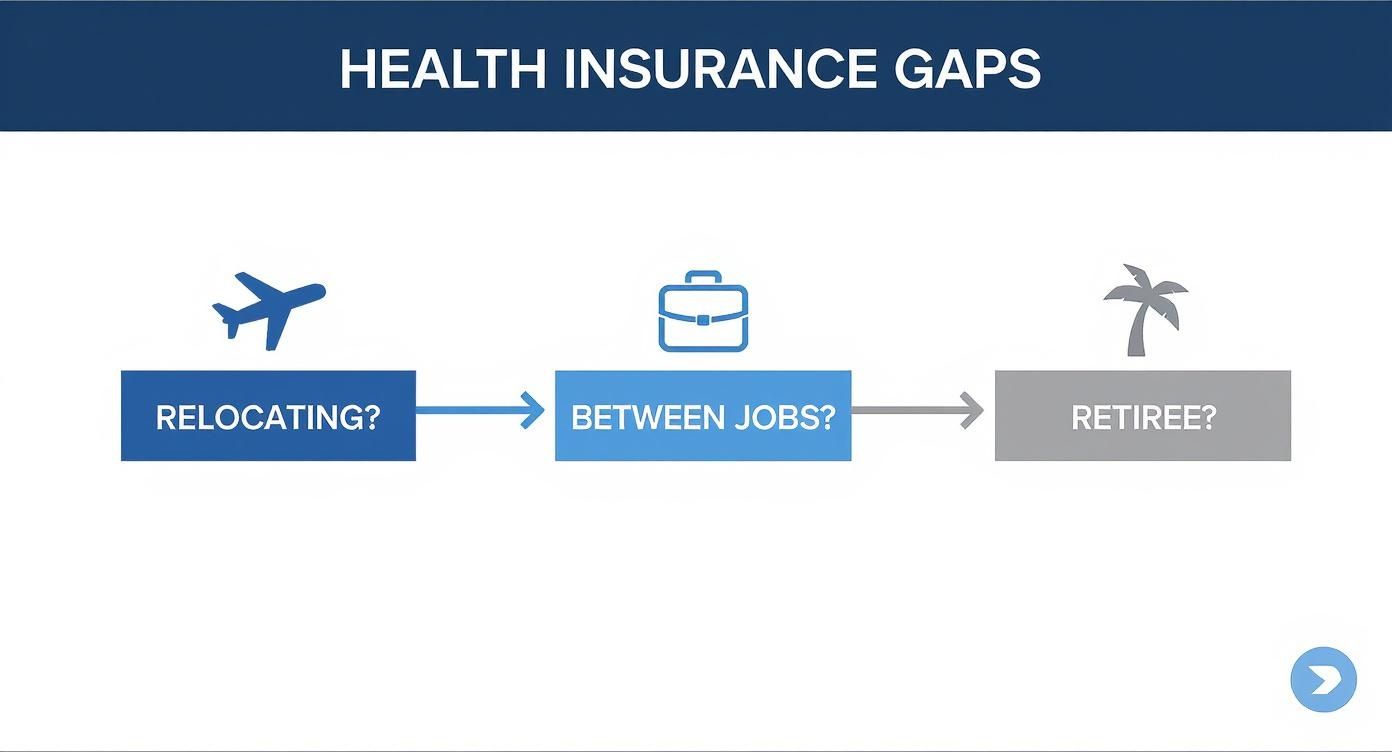Let's be unequivocally clear: a health insurance gap in coverage is not a minor administrative oversight. It is a critical vulnerability in your financial and personal defenses—any period, regardless of duration, where you are operating without a safety net. You are completely exposed to medical costs, a scenario that arises more frequently than one might anticipate.
This is not merely about being uninsured. It concerns the unforeseen periods of vulnerability that emerge during significant life transitions—such as changing executive roles, relocating internationally, or encountering restrictive fine print in a new policy.
Understanding Your Health Coverage Blind Spots

Consider your health insurance a sophisticated security system for your most invaluable asset: your health. A coverage gap is a blind spot in that system. The cameras are off, the alarms are silent, and you are left entirely vulnerable to any medical event that may occur. For high-net-worth professionals and global citizens, these gaps represent a direct threat to both well-being and wealth preservation.
What do these blind spots look like in practice? It could be the perilous month between exiting one executive role and commencing the next, after your former employer-sponsored plan has terminated. Perhaps you have just relocated abroad, only to discover that your domestic policy is rendered useless in your new country of residence. It could even be a mandatory waiting period before a new national health system provides coverage.
A health insurance gap is not a question of if a risk will materialize, but when. The only reliable defense against the disruption a minor medical event can cause is proactive, meticulous planning.
The consequences extend far beyond out-of-pocket hospital bills. A coverage gap can disrupt the continuity of care for a chronic condition, force the delay of vital treatments, and ultimately jeopardize your long-term health.
The Global Scale of Coverage Gaps
This is not merely an individual concern; it is a significant global challenge. Despite progress over the last two decades, the worldwide health insurance gap remains alarmingly wide. According to the World Health Organization, efforts toward universal health coverage have largely stagnated since 2015.
As of 2021, an estimated 4.5 billion people—more than half the global population—were not fully covered by essential health services. This exposure creates devastating financial hardship, with approximately 1 billion people incurring catastrophic out-of-pocket health expenditures. You can examine the data on global health coverage from the WHO to appreciate the full scope.
Why This is Critical for Your Portfolio
For an individual who meticulously plans every aspect of their financial and business affairs, overlooking health coverage continuity is a fundamental error with catastrophic potential. Too many successful individuals assume their coverage is a constant. That assumption can lead to severe and costly consequences.
The true cost of a health insurance gap is not measured solely by the figures on a medical invoice. It is measured in the potential derailment of your personal and professional trajectory. The first step toward building a genuinely resilient personal security plan is understanding the common traps that create these gaps. It is about ensuring your health and wealth are never left to chance.
How Coverage Gaps Ambush Global Professionals
For a high-achieving professional, a health insurance gap in coverage is not an abstract concept—it is a landmine poised to detonate your career and financial stability. While the average individual might be concerned about a gap between local employment, your world is infinitely more complex. The very nature of a global career, defined by international assignments and high-stakes transitions, creates unique vulnerabilities.
These are not vague, distant risks. They are specific pressure points that can fracture even with the most diligent planning. Without a precise understanding of where these traps lie, even the most successful executives can find themselves dangerously exposed, facing catastrophic financial and health outcomes.
The Waiting Game: Career Transitions and Coverage Blackouts
One of the most common ways to fall into a coverage gap is during a transition between senior roles. Upon leaving one company, your employer-sponsored health plan typically terminates at the end of the month. The complication? Your new employer’s plan often does not commence on day one.
Many corporate policies impose a mandatory waiting period of 30, 60, or even 90 days before new hires are eligible for health benefits. This creates a predictable—yet frequently ignored—chasm in your coverage. During this window, you are entirely liable for any medical costs, from a sudden illness to a serious accident.
A senior private equity partner accepted a new role in London. His previous U.S. plan ended on May 31st, but his new U.K. corporate plan had a 90-day waiting period, meaning it would not start until September 1st. In July, a severe case of appendicitis required emergency surgery. The final invoice exceeded £25,000, all out-of-pocket, because he had operated under the assumption of continuous coverage.
The International Assignment Trap
Relocating for an international assignment is another classic pitfall. Your domestic health insurance policy, whether from the U.S., the UK, or any other nation, was not designed for life abroad. Most offer little more than basic emergency care for a short holiday, not comprehensive coverage for someone living and working in a new country.
This means you have a critical health insurance gap in coverage from the moment your plane lands. Relying on your home country's plan while on an overseas assignment is a significant gamble; it will almost certainly be voided for anything beyond a true, short-term travel emergency.
Hidden Gaps: Navigating Policy Fine Print and Underinsurance
Sometimes, the most dangerous gaps are those concealed within your policy's fine print. These are the exclusions and limitations you only discover when filing a claim—precisely the worst time.
- Hazardous Activities Exclusions: Many standard plans refuse to cover injuries from activities they classify as "high-risk," such as skiing, scuba diving, or mountaineering. For professionals who balance a demanding career with an adventurous lifestyle, this is a significant blind spot.
- Pre-Existing Condition Clauses: When you switch plans, especially across borders, your new policy might not cover pre-existing conditions immediately. Many international plans have a waiting period, or "moratorium," before they will cover any known health issues.
- Geographic Limitations: Your expatriate plan might be superb in your country of residence, for example, Singapore. However, if you travel for a business deal in the Middle East or North America, you could find your coverage is drastically reduced or non-existent.
Of course, the onus is not entirely on the individual. Forward-thinking employers are increasingly recognizing their role in closing these gaps. Many are investing in robust corporate wellness programs to better support the health and resilience of their global teams.
Ultimately, recognizing these scenarios for what they are is the first step toward constructing a bulletproof health and financial strategy. Once you accept that these gaps are an inherent part of the landscape for a global career, you can shift from a reactive to a proactive posture, ensuring you are never caught unprotected.
The Financial Risks of a Coverage Gap

To be blunt, a health insurance gap in coverage is not merely an inconvenience; it is a direct threat to your wealth. For successful professionals and expatriates, an unexpected medical event without coverage can transform a health crisis into a full-blown financial catastrophe. It is a period where your entire financial structure is left defenseless against unlimited, unpredictable medical costs.
The most immediate danger is catastrophic out-of-pocket expenses. A sudden accident, a critical illness diagnosis, or emergency surgery can generate invoices that spiral into hundreds of thousands of dollars, or even more. Without a robust policy to absorb these costs, the burden falls directly on your personal assets, capable of erasing years of careful financial planning in a matter of weeks.
This exposure is escalating. Due to relentless global medical inflation, the cost of being uninsured—even for a short time—is higher than ever. The Global Medical Trends Survey projects gross medical trends to hold at a staggering 10.4% in 2025. With 64% of insurers worldwide bracing for even higher trends, the potential damage from a coverage gap is accelerating rapidly. You can examine the figures yourself in the 2025 Global Medical Trends Survey report.
The Hidden Threat of Underinsurance
Beyond being completely uninsured, there is a more subtle yet equally dangerous risk: underinsurance. This occurs when you technically have a policy, but it is critically inadequate for your actual needs. It creates a false sense of security while leaving you exposed to massive financial liabilities.
Underinsurance can create a de facto health insurance gap in coverage in several ways:
- Exorbitant Deductibles and Co-pays: Your policy may exist, but if you are required to pay tens of thousands of dollars out-of-pocket before it activates, you are functionally uninsured for a wide range of medical issues.
- Restrictive Network Limitations: An international plan may have a very limited network of approved hospitals. If you require care outside that network, even in an emergency, your insurer might cover only a small fraction of the bill—or nothing at all.
- Policy Exclusions: This is where the devil resides, in the details. Many plans have specific exclusions for pre-existing conditions or certain treatments. Failure to scrutinize this fine print can lead to a devastating claim denial precisely when you need support most. We explain how to navigate this in our guide to medical conditions and policy exclusions.
The Compounding Costs of Delayed Care
The financial impact of a coverage gap does not end with direct medical bills. Lacking reliable coverage often compels individuals to delay necessary medical care, a decision that carries its own steep price. Postponing a diagnostic screening or ignoring a persistent symptom can allow a manageable condition to escalate into a much more serious—and costly—illness.
A temporary coverage gap can lead to permanent health consequences. The decision to delay care due to cost concerns is a gamble against time, where the stakes are both your long-term health and your financial stability.
For anyone managing a chronic condition, the consequences are even more severe. An interruption in coverage shatters the continuity of care. It becomes difficult to obtain essential medications or consult with specialists. This break in treatment can trigger a significant health decline, leading to more complex and expensive interventions later on.
Ultimately, a health insurance gap is an uncalculated risk that attacks the very foundation of your personal and financial well-being.
Real-World Scenarios: Where Coverage Gaps Get Expensive
It is one thing to discuss risk in theory. It is another to observe how a health insurance gap in coverage unfolds in the real world. Let's examine a few common situations faced by globally mobile professionals to see just how quickly these gaps appear—and what it takes to close them.
These are not mere hypotheticals; they are case studies that highlight the real financial stakes. Each scenario breaks down the challenge, the potential damage, the appropriate solution, and the hard-won lesson. It is a masterclass in why proactive planning is non-negotiable for protecting your health and wealth.
The Executive Relocation: New York to Dubai
First is Michael, a senior banking executive moving from New York to Dubai to launch a new division. His U.S. company's health plan was scheduled to terminate on his last day, May 31st. The problem? His comprehensive new policy in the UAE would not activate until his official start date on July 1st.
This left a one-month gap where Michael and his family were completely exposed. He rationalized that they could simply be cautious for a month and save the expense. That assumption dissolved when his young son had a minor playground accident. A brief visit to a private emergency room for a few stitches resulted in a bill exceeding $3,000.
- The Challenge: A 30-day gap between the end of a U.S. policy and the start of a UAE-based plan.
- The Potential Damage: Unlimited exposure to Dubai's high private healthcare costs, where a serious medical event could easily cost tens or even hundreds of thousands of dollars.
- The Solution: Michael should have secured a 30-day international short-term medical plan to protect his family in the UAE before the new policy commenced.
- The Lesson: Never assume a short gap is a safe gap. The cost of temporary bridge coverage is a minuscule fraction of what even a minor medical issue can cost out-of-pocket.
The Consultant Between International Contracts
Next, let’s consider Sarah, an independent management consultant in the fintech sector. She works on a project basis, which often leaves her with weeks or even months between major international contracts. After concluding a six-month project in Singapore, she planned to spend two months at her home base in London before starting her next engagement in Hong Kong.
Her client-provided insurance from the Singapore project expired the moment the contract ended. This left her uninsured during her downtime in London and for the relocation to Hong Kong. While she had access to the NHS for true emergencies in the UK, she knew she was liable for any private care, specialist visits, or health issues arising while traveling to Asia.
A coverage gap between contracts is not a vacation from risk—it is a period of maximum financial vulnerability. When there is no corporate safety net, your own diligence is the only thing standing between you and a massive bill.
To close this health insurance gap in coverage, Sarah procured a flexible, multi-country short-term private medical insurance policy. It provided comprehensive global protection that she could activate for the exact 60-day period required. This ensured she had access to private care in London and was fully covered during her relocation. It also simplified matters like navigating pre-authorisation and direct settlement procedures, which can be a significant administrative burden when in transit.
The Early Retiree with a Global Itinerary
Finally, meet David. After a successful career in private equity, he retired early at 55. He maintained his top-tier domestic health plan in his home country of Australia, believing it was more than sufficient for his new lifestyle of spending three to four months a year traveling through Southeast Asia and Europe.
He discovered how mistaken he was during a trip to Thailand when he experienced a sudden, non-emergency cardiac issue. His Australian insurer bluntly informed him that his policy would only cover a small, capped amount for overseas emergencies. It would not cover the extensive diagnostic tests recommended by specialists in Bangkok. David was suddenly facing over $20,000 in out-of-pocket costs just for the initial workup.
This type of "gap within a policy" is not unique. The U.S. has its own systemic issues. In the ten states that have not expanded Medicaid, approximately 1.4 million people are in a coverage gap—their income is too high for Medicaid but too low to qualify for marketplace subsidies. The uninsured rate in those states is 14.1%, nearly double the 7.6% rate in expansion states. As KFF findings on the U.S. coverage gap show, this situation forces individuals to forgo necessary care due to cost, proving that even domestic plans can conceal dangerous gaps.
David's solution was to immediately purchase a comprehensive annual international private medical insurance (IPMI) policy designed for global citizens. This gave him robust, borderless coverage, protecting him regardless of where his travels took him. The lesson here is crystal clear: a domestic plan is built for a domestic life. True global mobility demands a dedicated global health strategy.
Proven Solutions for Your Coverage Gap
Recognizing a health insurance gap is one thing; resolving it is another. The key is to be proactive, not reactive. You do not want to be scrambling for a solution when an emergency strikes. Fortunately, several robust options exist to build a bridge over that gap, each suited for different life transitions.
Choosing the right path boils down to your specific circumstances. Are you moving overseas? Switching executive roles? Perhaps you are entering early retirement. This decision tree outlines the main options to consider based on your current situation.

The primary takeaway is that there is no one-size-fits-all answer. Every scenario, from a simple job change to a complex international relocation, has a specific tool for the job. You require a strategy that fits your needs.
COBRA Continuation Coverage for U.S. Professionals
For professionals in the U.S. leaving a company, the Consolidated Omnibus Budget Reconciliation Act (COBRA) is a powerful instrument for continuity. It allows you to retain the exact same health plan you had with your former employer for up to 18 months.
This provides significant peace of mind. You keep your doctors, your specialists, and your network—ensuring no disruption to your care. However, this stability comes at a substantial price. You become responsible for the full premium, which includes both your share and your former employer's contribution, plus a small administrative fee. This can be a significant financial adjustment.
Consider COBRA a premium, tactical solution for the short term. It is ideal for bridging a few months before a new company plan activates, especially if you or a family member are undergoing ongoing medical treatment.
Short-Term Private Medical Insurance
When COBRA is not an option—or is simply too costly—short-term private medical insurance offers a more flexible and often much more affordable alternative. These plans are specifically designed to plug temporary gaps, typically for periods ranging from 30 days up to a year.
Let's be clear: these policies are not intended for comprehensive, long-term care. They are your financial shield against a sudden, catastrophic medical event. Most will exclude pre-existing conditions and will not cover routine check-ups. Their true strength lies in speed and agility. You can often obtain coverage starting the very next day, which is invaluable for those last-minute gaps.
When evaluating short-term plans, keep these points in mind:
- Coverage Scope: What is actually covered? Emergency room visits, hospital stays, and surgery are usually standard, but check the fine print on items like prescription drugs.
- Network Limitations: Ensure you know which hospitals and physicians are in-network. Going out-of-network can result in unexpected bills.
- Geographic Restrictions: Is the plan valid where you will actually be? A policy that only covers you in Florida is useless if you are spending your gap period in California.
International Private Medical Insurance for Global Citizens
For expatriates, digital nomads, or anyone moving abroad, a domestic or short-term plan is insufficient. They are fundamentally the wrong tool for the job. The definitive solution is a dedicated international private medical insurance (IPMI) policy. These plans are engineered for a life without borders.
An IPMI plan provides comprehensive, portable coverage that follows you across multiple countries. It ensures you have access to high-quality private healthcare no matter where your life or career takes you. Unlike domestic policies, they are built with the unique challenges of a global citizen in mind—consider multi-currency options, multilingual support, and direct billing with top-tier hospitals worldwide. To delve deeper, you can learn more about the specifics of international private medical insurance plans in our detailed guide.
To help you weigh your options, this table breaks down the core features of each solution.
Comparison of Coverage Gap Solutions
This table compares key features of common solutions for bridging a health insurance gap, helping professionals choose the best option for their situation.
| Solution Type | Ideal For | Typical Duration | Geographic Coverage | Key Consideration |
|---|---|---|---|---|
| COBRA | U.S. professionals between jobs needing to keep their exact plan and doctors. | Up to 18 months | U.S. based (same as original plan) | High cost, as you pay the full premium plus an administrative fee. |
| Short-Term Medical Insurance | Individuals needing quick, affordable coverage for catastrophic events. | 30 days to 1 year | Typically limited to a specific U.S. state or region. | Excludes pre-existing conditions and routine care. |
| International Private Medical (IPMI) | Expats, frequent travelers, and individuals relocating abroad. | Annual, renewable | Global or specified regions | Comprehensive, portable, and designed for a borderless lifestyle. |
Ultimately, selecting the right tool demands a clear-eyed assessment of your needs, your timeline, and your geographic footprint. For more insights into navigating coverage gaps, check out the Salthea blog for diverse perspectives. Each option offers a distinct advantage, ensuring that with proper planning, a health insurance gap is an entirely avoidable risk.
Building a Resilient Healthcare Strategy
Let’s be direct. Treating a health insurance gap in coverage with a quick fix is akin to applying a small bandage to a major wound. It may offer a temporary stopgap, but it fails to address the underlying vulnerability. For high-net-worth individuals and global professionals, a truly resilient strategy means moving beyond reactive patches.
It is about weaving your healthcare plan directly into the fabric of your long-term wealth management and lifestyle design. This represents a fundamental shift in mindset. You cease plugging gaps as they appear and instead construct a fortress where those vulnerabilities cannot form in the first place.
This approach views premium health coverage not as just another expense, but as a strategic investment. It is an active shield protecting your two most critical assets: your health and your financial legacy. A single, unexpected medical catastrophe can shatter both, and leaving them exposed is a risk no successful individual should be willing to take.
Adopting an Executive Approach to Health Coverage
Building this level of resilience demands that you take command of your healthcare plan. Consider it a key holding in your investment portfolio—it requires disciplined, ongoing review and optimization. The objective is to keep your coverage perfectly synchronized with the evolving demands of your personal and professional life.
This is not a passive, set-it-and-forget-it task. Here is what it looks like in practice:
- Conduct Annual Policy Reviews: This is non-negotiable. Schedule a deep-dive with a specialist broker every single year. This is not a cursory skim of the summary; it is a forensic analysis. You will map your coverage against your plans for the next 12 months—identifying travel destinations, potential relocations, or any changes in your family structure.
- Master International Nuances: You must know precisely what your plan does and, more importantly, what it does not do in different countries. Scrutinize the geographic limitations. Confirm how it performs in the locations you frequent for business or leisure, especially concerning direct billing arrangements and in-network hospital access.
Partnering with Specialized Expertise
Attempting to navigate this complex world alone is a recipe for disaster. Just as you would not manage a multi-million dollar portfolio without a financial advisor, you should not manage your global health coverage without a specialist broker.
You need an expert who lives and breathes the unique challenges of globally mobile professionals. These are the individuals who can identify the subtle risks—the hidden clauses in the fine print—that a generalist broker would almost certainly miss.
True resilience is not about having just any policy; it is about having the right policy, meticulously vetted and perfectly matched to your unique global footprint.
When you frame your health insurance this way, it ceases to be a static document filed away. It becomes an active, powerful tool for asset protection. This is what empowers you to operate with confidence anywhere in the world, knowing you have secured one of the most critical vulnerabilities in your personal security.
Frequently Asked Questions
It is entirely normal to have questions when facing a potential health insurance gap. Obtaining direct, practical answers is the only way to make a sound decision that protects both your health and your finances. Let's address the most common uncertainties we see global professionals grapple with.
The objective here is simple: cut through the jargon, resolve any lingering doubts, and provide you with the confidence to manage your own situation with professional acumen.
How Long Can I Rely on a Short-Term Health Insurance Plan?
Consider a short-term plan a tactical tool, not a long-term strategy. It is the spare tire in your vehicle—invaluable for getting you safely to a service center, but not intended for extended use. It is designed to bridge a very specific, temporary gap.
In the United States, for example, federal guidelines typically cap initial terms at just under 12 months. Renewal may be possible up to a total of 36 months, but this varies significantly by state. For international scenarios, these plans can provide coverage for periods ranging from a few days to a year. The key is to see them for what they are: an ideal stopgap measure while you are between roles or waiting for a permanent policy to activate.
Will My Domestic Health Insurance Cover Me When I Move Abroad?
In almost every case, the answer is an emphatic no. Most domestic health insurance plans—whether private or government-sponsored—provide negligible coverage outside your home country's borders. At best, they might cover a small portion of a true, short-term travel emergency, but they were never designed for someone actually residing abroad.
Relying on a domestic plan for an international move is not just a risk; it is a guaranteed health insurance gap in coverage the moment your plane lands.
For any expatriate or professional spending significant time overseas, a dedicated international health insurance plan is non-negotiable. These policies are engineered from the ground up for a global lifestyle, providing comprehensive, portable coverage that follows you wherever your career takes you.
What Is the Best Way to Avoid a Coverage Gap When Changing Jobs?
The only foolproof method is proactive, detailed planning. Before you even consider submitting your resignation, you must have a crystal-clear map of your options and a precise timeline.
If you are in the U.S., you may have access to COBRA, which allows you to continue your exact same employer plan for up to 18 months. The caveat? You are responsible for the full premium, which can be prohibitively expensive. A short-term private policy is often a more cost-effective solution to bridge that gap until your new company's benefits commence.
Here is the most critical element: you must ensure your new coverage begins the exact day your old one ends. Never assume an automatic grace period exists. It is your personal responsibility to verify the start and end dates of every policy involved. That is the only way to completely eliminate your exposure.
Navigating the world of international health insurance demands a specialist's touch. At Riviera Expat, we offer bespoke advisory services for high-net-worth professionals, ensuring your healthcare strategy is as robust and mobile as your career. Schedule a complimentary consultation with our specialists today.

